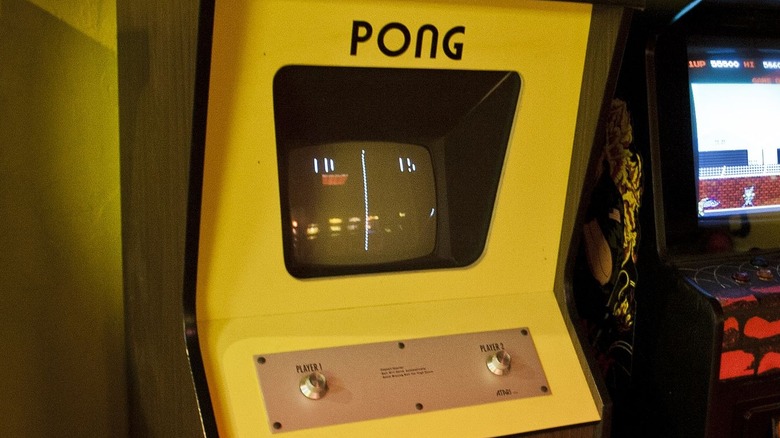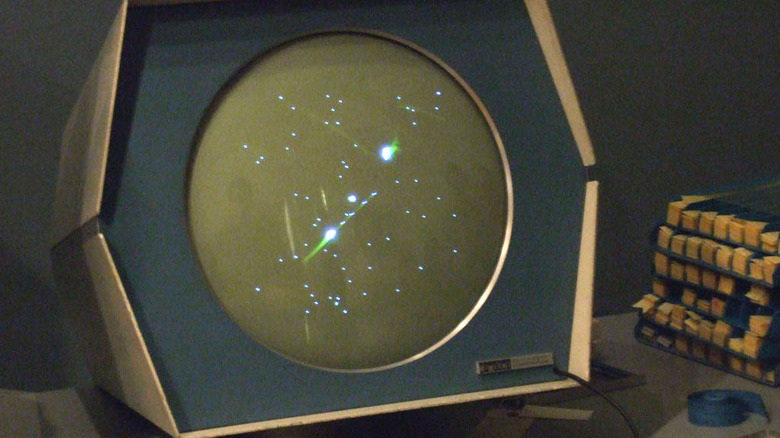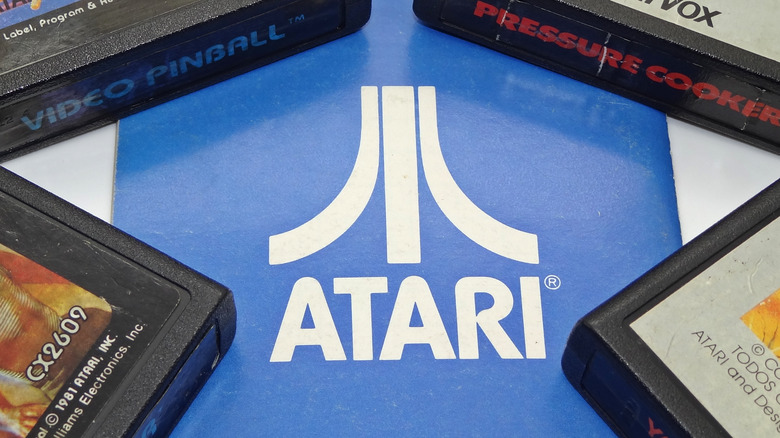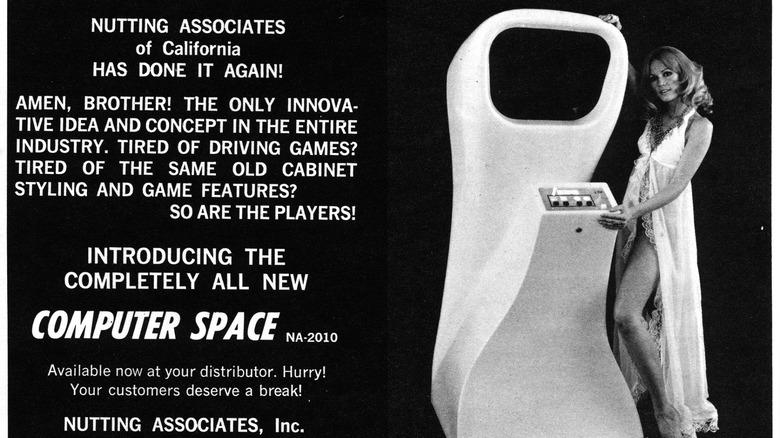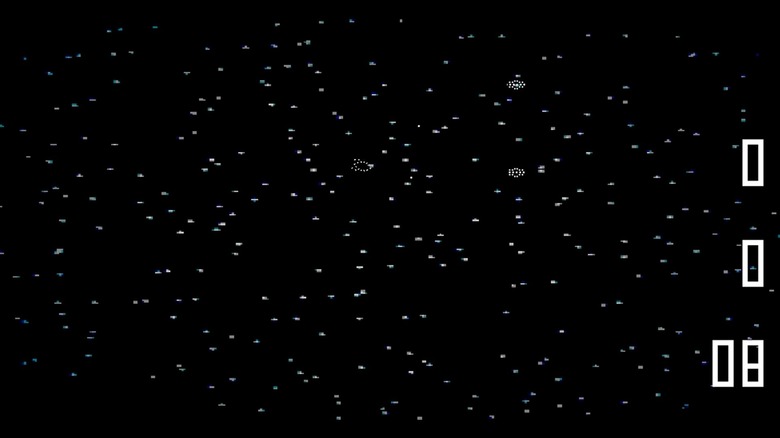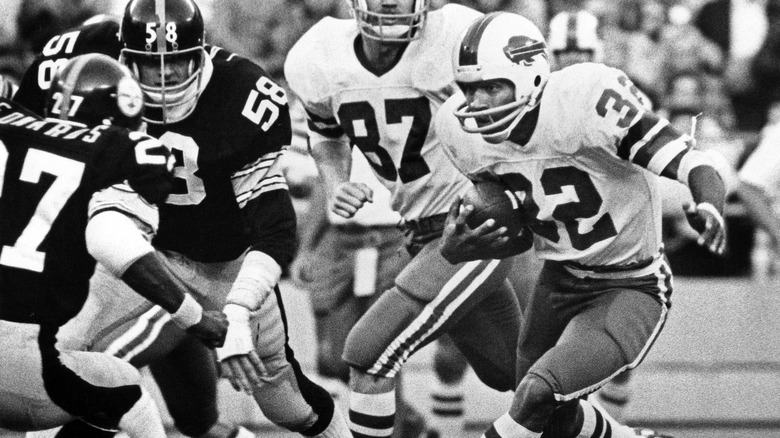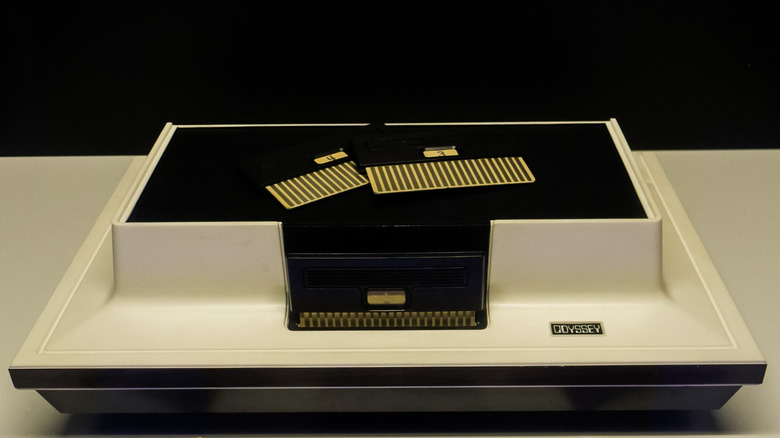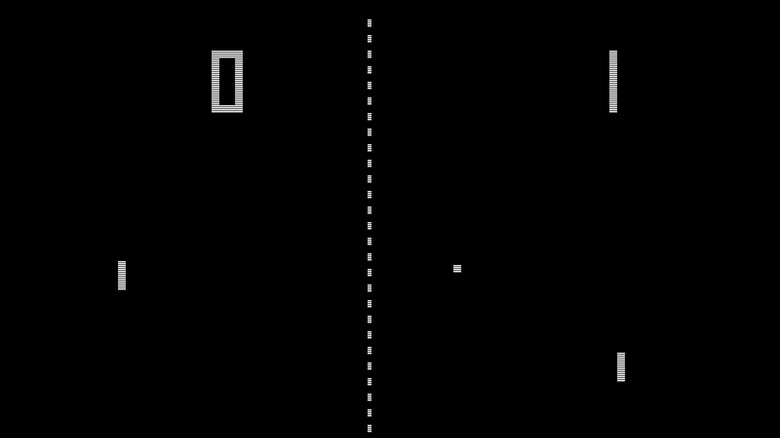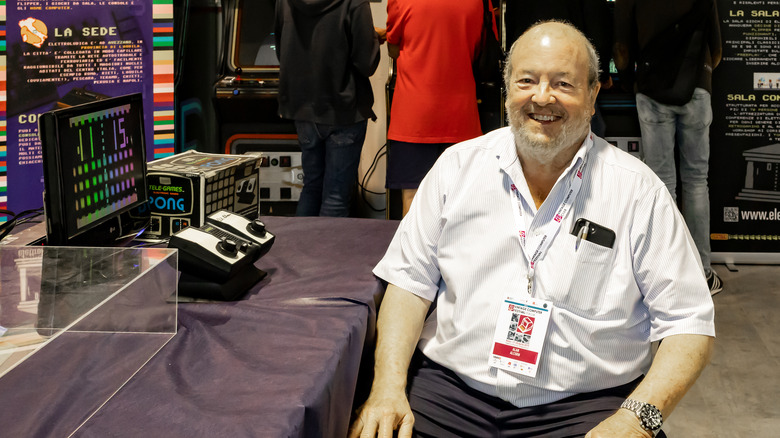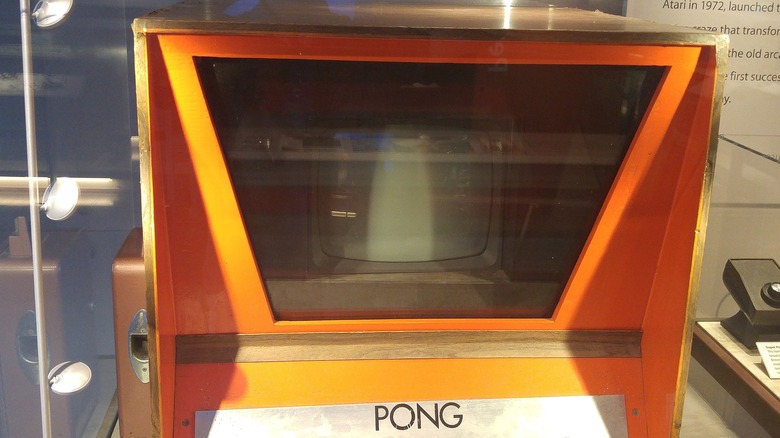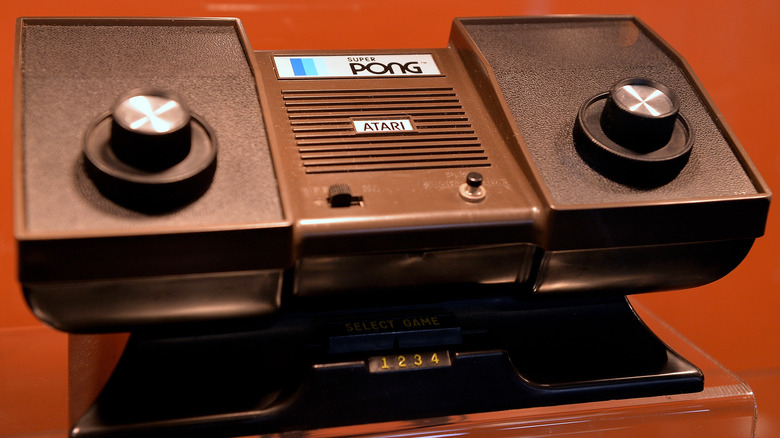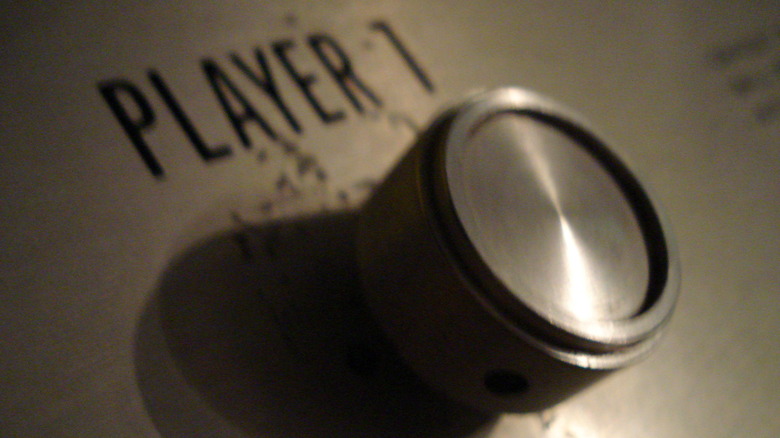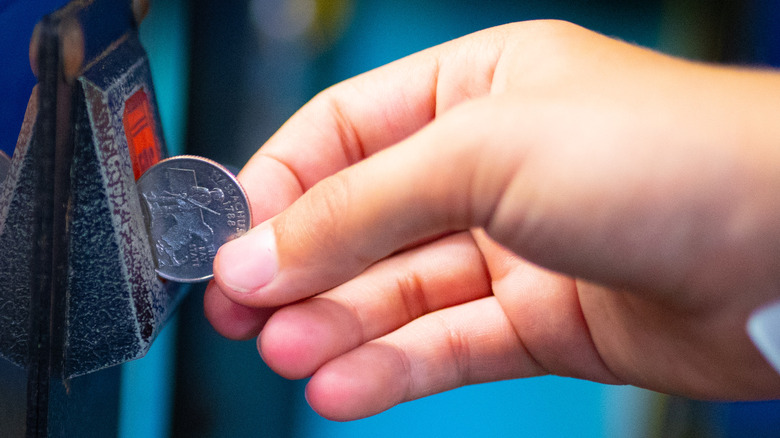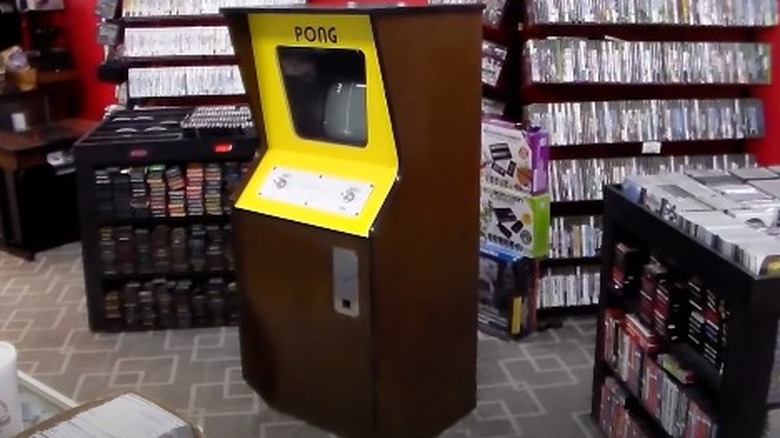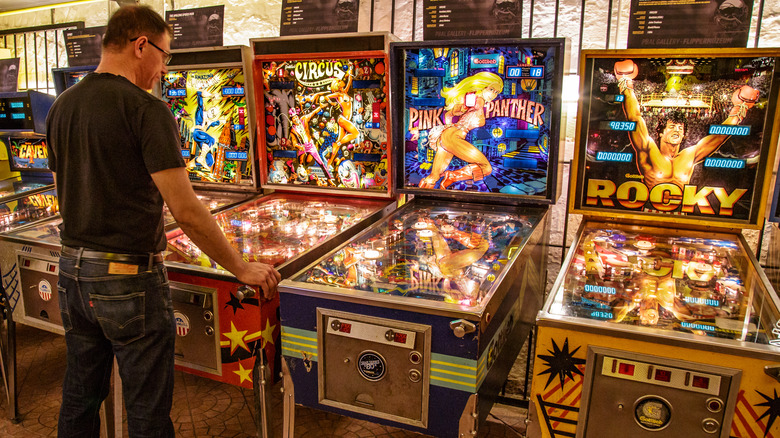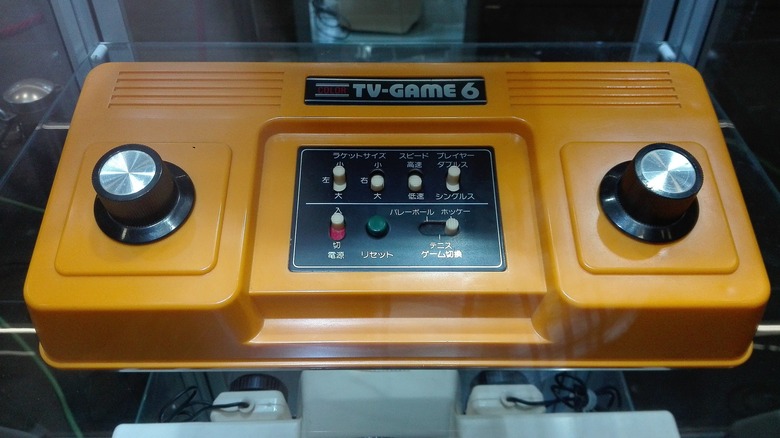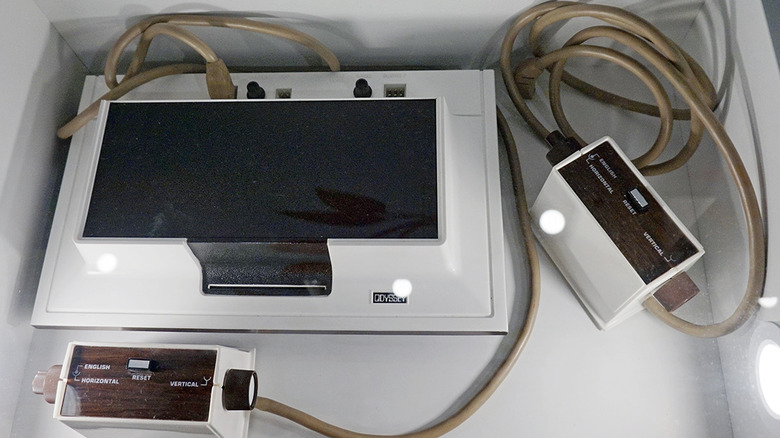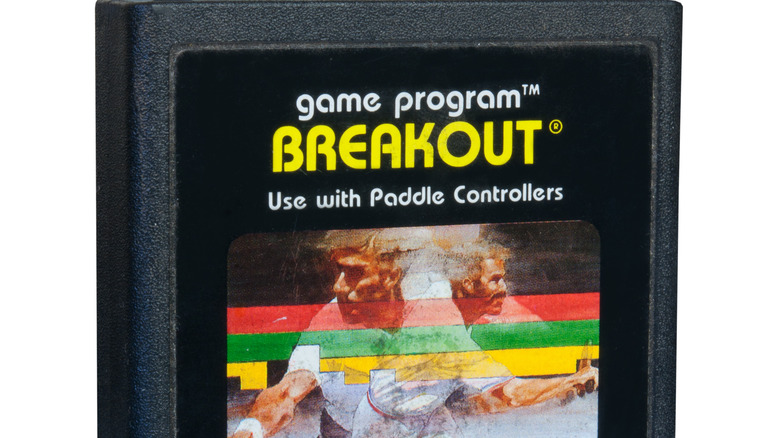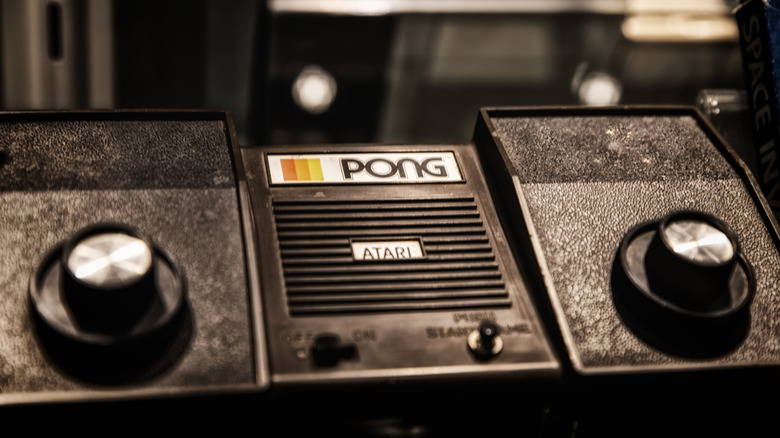The Untold Truth Of Pong
Pong was the first commercially successful video game in history and arguably the most influential. Not only was it the first viable electronic arcade game, but it was how home game consoles became popular. The Guardian, in reflecting on the influence of "Pong," emphasized that it was the first time that television owners could interact with and control what was occurring on their TV screens. It may be hard to appreciate, since Pong as a game is as simple as simple gets – two rectangles on the screen bouncing a square ball back and forth. Nevermind that. At its birth, "Pong" was revolutionary and the company that brought it forth, Atari, became cemented in gaming lore.
In that way, the truth is that every video game from "Tetris" to "Grand Theft Auto" was influenced by the groundbreaking impact of "Pong." However, the story of "Pong" and its creation have lots of quirky details and more spin than any paddle can make on a ball, virtual or not. So let's put on our bell bottoms and step back in time to nearly five decades ago to look at when Led Zeppelin was at the height of their rocking powers and "Pong" was the first and undisputed king of the video game world.
Pong was not the first video game
"Pong" was not the first video game, but it was the first one that was commercially viable. The truth is that the first video game was, according to Game Developer, Alexander Douglas's "OXO" from 1952. The game was essentially tic-tac-toe against the mainframe computer at the University of Cambridge. Closer in structure to "Pong" was 1958's "Tennis for Two" developed at the Brookhaven National Laboratory by William Higinbotham. This game featured a moving ball that seemed to be affected by gravity.
Neither "OXO" or "Tennis for Two" had many players. More influential was the mainframe game "Spacewar!" This game, originally written by Steve Russel, Martin Graetz, and Wayne Wiitanen at MIT in 1961, had two players dueling each other in simple starfighters. The game simulated physics and later versions of it used controllers such as a surplus jet joystick. "Spacewar!" was taxing on the computers of the time making 100,000 calculations per second to execute the game. "Spacewar!" would prove to be influential on a young crop of engineers who saw the possibilities of electronic gaming.
Pong was developed by a startup
The company that developed "Pong" was Atari, which was destined to become a legend in the gaming world. The main person behind Atari was Nolan Bushnell. According to an oral history kept by the Smithsonian, he was born in Clearfield, Utah to a Mormon family. At an early age, he tinkered and took to electronic engineering. After seven years in college, he graduated from the University of Utah in 1968. He then obtained a job at Ampex, an electronics company, where he met another engineer, Ted Dabney. Bushnell, however, was no shy engineer. He was enthusiastic, outgoing and charismatic. He had even been a carnival barker who had been thoroughly exposed to the possibilities of gaming. Wired explains that he and Dabney put in $350 each (Bushnell later claimed $250) to start up a new company which Bushnell envisioned would be at the forefront of a new industry. They originally named they company Syzygy, which refers to an astronomical alignment of three heavenly bodies. They soon found that the name had already been taken by a candle maker. So, in 1972 the company incorporated under the name "Atari" which is reference to a check move like in chess, but in the game of Go.
Atari's mission was to design games for companies such as Bally to manufacture and sell. Bushnell and Dabney soon created their first product, which they licensed to Nutting Associates, who built "Computer Space."
Computer Space was the pre-Pong flop
Bushnell and Dabney's "Computer Space" was the first commercial coin-operated electronic arcade game. Debuting in 1971 at the Music Operators of America Trade Show in Chicago, the MIT Press Reader tells us that the game was cloaked in a very cool looking, futuristic cabinet. The game featured a starfighter battling two UFOs in space. Considering the growing popularity of science fiction at the time, Bushnell and Dabney may have logically assumed it was going to be a big hit.
The truth is that "Computer Space" was really an attempt to bring the concepts of "Spacewar!" to a paying audience. Also, despite being called "Computer Space" the game used television technology, rather than computers. Another truth is that the game, despite its innovations, was a flop. Bushnell would claim that the controls were too complicated and that he overestimated the gaming intelligence of the inebriated players at the bars, who were his intended market. The MIT Press Reader analysis claims that a problem was that it lacked simulated gravity, which couldn't be used in the television technology of "Computer Space." In any event, the game playing experience was poor.
Ted Dabney created arcade game technology
Those who have some passing knowledge of the story of "Pong" usually give credit to Nolan Bushnell and Allan Alcorn (more on him to come), forgetting about Ted Dabney. The truth is that Ted Dabney has until pretty recently been a largely forgotten figure in the history of video game development. But without Dabney, "Pong" would never have happened.
According to the New York Times, Dabney was born in San Francisco in 1937 and learned engineering while in the Marine Corps in the 1950s. After partnering with Bushnell, Dabney developed a way to create computer games without the computer. The problem was that for computers to run a video game of the day they'd have to be immense, since they could not keep up with video speeds. So, he developed the video circuitry which, according to IGN, would allow dots to move on a screen without the assistance of a massive computer. This was called the Spot Motion Circuit and it allowed for the development of the classic arcade cabinet type games.
It seems that Dabney was largely forgotten because he was in Bushnell's larger shadow and also because he split from Atari early in 1973 after tensions with Bushnell. NPR reported that Dabney claimed that Bushnell was taking over more and more of the operations and the direction of the company.
The primary builder of Pong tackled OJ Simpson
The engineer who was most responsible for putting together the nuts and bolts of "Pong" was Allan Alcorn. From an oral history kept by the Computer History Museum, we learn that Alcorn was born in 1948 in San Francisco and had a natural aptitude for engineering. However, the truth is that Alcorn, at least as a young man, was more jock than nerd having played All-City football with the notorious O.J. Simpson. In another oral history collected by the Smithsonian, Alcorn seemed to relish this, claiming, "I was a football jock, and I actually tackled O.J. Simpson a few times."
Alcorn attended the University of California at Berkeley where he started playing football, but then decided to go "full nerd" and pursued electronics. After college, IGN tells us that he ended up working at Ampex which is where he made a connection to Nolan Bushnell. Bushnell recruited Alcorn to Syzygy (soon to be Atari) over lunch where Bushnell showed off a blue station wagon, which he explained was the company car. Alcorn was hooked, even though he would have to take a pay cut from $1,200 a month to $1,000.
Pong was a ripped off idea
By the time Allan Alcorn came to Atari, "Computer Space" had already flopped. Wired points out that Alcorn probably took a greater risk of joining Atari than Bushnell. The truth is that although he and Dabney founded the company, Bushnell was still fully employed with Nutting, the company that built and licensed "Computer Space."
By May 1972, Bushnell was searching for ideas when he attended a demonstration of a game system produced by Magnavox called the Odyssey ITL200. Game Developer explains that this system, invented by Ralph Baer, was the very first home video gaming system. It was at the demonstration that Bushnell played a game called "Table Tennis." This was essentially "Pong," but with some differences. The ball, for example, would be out when it ran into a side wall, where in "Pong" the ball would bounce off of it. The game also featured "ENGLISH," which controls the trajectory of the ball to some degree. Bushnell left the demonstration. Thus, the real truth about "Pong" is that the idea came from Ralph Baer.
Allan Alcorn was tricked into creating Pong
Nolan Bushnell gave Allan Alcorn an assignment. As related by an IGN interview with Alcorn, Bushnell told Alcorn that they had a contract with General Electric. He was to build "the simplest game, One moving spot, two paddles, score digits." Bushnell had lied to the engineer and ostensibly had given him the task as a way to test his acumen with the video positioning technology. Alcorn had limited experience with the technology, so Bushnell apparently wanted to put the young engineer through the paces. According to Wired, Bushnell said that it had to be made with 20 chips at most.
Thus inspired by the GE story, Alcorn set to work purchasing a high quality black and white television from a department store on El Camino Real for the purpose. While Alcorn knew nothing about Odyssey's "Table Tennis" he received direction from Bushnell. According to Wired, Alcorn built segmented paddles that controlled the motion of the players. He then came up with some unique features that would make the game more playable. The ball would speed up over rounds. If it hit different areas of the paddle it would go off in different angles.
Al Alcorn made a unique and addictive game
Bushnell demanded sounds. According to Wired, he wanted cheering crowds (Dabney wanted boos and jeers). While Alcorn couldn't do that, he did develop the "Pong" sound when the ball was hit – a sound that would symbolize the early video game era, and something he was able to pick up off of the available circuitry. After three months, Alcorn had developed a prototype, albeit with 70 chips, 50 more than what Bushnell told him was the maximum. When Bushnell played the prototype, he grew excited – it was a "great game." The play was intuitive. When Alcorn expressed reservations about the game – since it had so many chips – Bushnell told him the truth. There was no GE contract and he was being tested. Alcorn would later state to IGN that while Bushnell got the idea of the game from the Odyssey, they had made a better game, claiming that "Table Tennis" was "impossible to play." In addition, Bushnell had low expectations for "Pong." It was merely meant to be a test. Alcorn stated to IGN, "...it's like the movie The Producers, because he [Bushnell] figured we'd rip off the idea for a game, but so what? It's no good, we're not going to sell it, we'll throw it away, so what harm is there, right?"
Pong debuted in a dive bar
Bushnell, Alcorn, and Dabney shoved the prototype into a wooden cabinet to give it a real world test. The chosen venue according to Wired was a smoke-filled bar named Andy Capps that dealt out swill and offered pinball machines. The owner knew them since they also repaired his pinball machines. He allowed them to set their prototype up on a decorative barrel.
The very first players of "Pong" were pinball players who despite there being no instructions figured it out. After one play, the first testers left the game alone. Curious, Bushnell approached them and inquired about the game. One of the players told Bushnell that he had played these types of games before and knew the guys who made them. Bushnell did not bother to enlighten him. About a week later, Vanity Fair reports that the bar manager called and complained the game was broken. Alcorn went to investigate and said that he needed to play a few games to figure out the problem. When he opened the lock to the coin box where the switch was to enable free games, he found that it was overstuffed with quarters. The solution to this problem was a bigger coin box – they switched from a coffee can to a milk carton. However, this story may not be true. Vanity Fair in its reporting stated that Loni Reeder, Bushnell's assistant, claimed that the Atari guys stuffed the box on purpose, possibly to fabricate buzz.
Drunkards were the first quality control testers of Pong
As it turned out, "Pong" was generating buzz just on its own. According to Wired, more prototypes were built and these were put into freestanding locked cabinets. This enabled for more quality testing at about 10 different bars. Allan Alcorn, in an oral history kept by the Computer History Museum, also stated one of these pioneer "Pong" units was at the student union at Stanford University. In any case, the truth is that it was in the bars where "Pong" was put through its paces. Wired tells us that intoxicated or mainly intoxicated players threw billiard balls at the game thinking it might allow a free play. Shaking the unit often caused it to short circuit and coins when inserted could even land on the circuitry and do the same damage. Bar owners even took a hand at tampering with the game since they were used to fixing pinball machines. They would open the backs and start turning an obvious dial that was the power supply. This seemed to be the main technical issue with these early "Pong" games.
Allan Alcorn thought Pong didn't need instructions
All signs showed that "Pong" was going to be a hit, but it needed improvements. To Bushnell's mind one glaring omission was that the game lacked instructions. An oral history kept by the Computer History Museum relates how Alcorn and Bushnell got into a fight over the issue. Alcorn said it was ridiculous to put on instructions. He stated, "If you have to have instructions no one will play it and no one would read it." Bushnell replied that pinball games have instructions to which Alcorn said they didn't. So the two looked at pinball machines and voila, instructions were on them in the back left. Alcorn was amazed, having never noticed them before. So the following instructions were put onto "Pong" units (as reported by Wired):
-
Deposit quarter
-
Ball will serve automatically
-
Avoid missing ball for high score
Another, more practical problem was control of the potentiometer which controlled the paddles. Alcorn initially built it using a 50 cent potentiometer from Radio Shack. These broke after a week from overuse. To analyze the problem, he counted the coins in used units and was surprised to learn that at 20 to 30 turns per game a "Pong" knob would be rotated a million times in its first three to four months. Atari ended up going to Allen-Bradley to furbish high end potentiometers.
Pong was such a big hit that one coin collectors wife carried a hatchet
People went to bars with the unit not for the beer but for the "Pong." IGN reports that each unit usually earned $40 per day, which translates to almost $300 in today's dollars. Atari split the proceeds with the venue 50-50. This was all in quarters. Atari sent out physical collectors with sacks to collect all the pilf. Wired describes how Steve Bristow, who worked part time as a pinball maintenance worker and coin collector soon found that he was hauling sacks carrying $600 to $1,000 in quarters. This was several times the take of a pinball machine. This is in 1972, so the amount was worth over $7,000 in today's money. He grew increasingly nervous that he was going to be robbed and applied for a gun permit, which was declined by the police. Instead, he recruited his wife, who marched in front of him carrying a roofing hatchet while he lumbered behind hauling the heavy money sacks.
Despite its burgeoning popularity, the truth is that there were actually relatively few "Pong" arcade units, despite the demand. Alcorn told Wired, " We manufactured about three thousand upright coin-op "Pongs." There were probably ten or twelve thousand manufactured in total." These units are now collectors items. Computer History gives a somewhat different figure. By the end of 1974, Atari had sold 8,000 units and eventually sold over 35,000.
Pong arcade cabinets were made short on purpose
Most people who have a passing familiarity with "Pong" lore know about the familiar bright yellow cabinets that carried the arcade version of the game. Surprisingly, "Game After" describes that to most players, the cabinet was surprisingly short when compared to later arcade games. This was done on purpose. Alcorn wanted the game accessible for children, plus smaller cabinets had the added benefit of using less material, and hence lower cost.
Another little known fact is that there were variations of the "Pong" cabinet. One type, "Barrel Pong" had the game inside a barrel where players looked down at it. This version did not last, although later variations had a cocktail table version of "Pong." Another rare "Pong" cabinet was the dog house shaped "Puppy Pong" which was at pediatricians' offices. For adults at the doctor, there was "Doctor Pong" which was a simple wooden cabinet.
Early Pong was considered seedy
"Pong" appeared on the scene in 1972, at a time where pinball machines were illegal in many localities. Slate relates how pinball had been banned in the 1940s for being associated with gambling and moral degradation. Why gambling? Early pinball machines lacked flippers, so people would bet on the outcome of a particular shot. Pinball was considered still a game of chance with a payout of a free game. In fact, New York City didn't lift its pinball ban until 1976. According to Wired, "Pong" was painted in the same seedy brush and with it the burgeoning video game industry. It probably didn't help that the first major profile of Nolan Bushnell was penned by one of Alcorn's frat brothers for Oui, a pornographic magazine.
Another trouble was related by Al Alcorn in the oral history kept by the Smithsonian. He pointed out that "Pong" was not creating a new market but entering an existing market of coin operated games (pinball machines). These were controlled by distributors. At one dinner hosted by a main distributor in San Francisco, Bushnell pressured Alcorn to go in his place. There at a table he met an operator, those who placed machines at bars and locations. After introducing himself to him, the man took out a pistol, put it on the table, and said, "You know, you're operating in my area." Alcorn replied, "We'll stop that right away."
The overall number of Pong arcade units was low
As mentioned, Al Alcorn, in an interview with Wired, stated that perhaps only 12,000 "Pong" arcade units were manufactured which seems rather small. IGN also reported that even when Atari entered the home console market in 1975 with a unit retailed by Sears, it sold 200,000 that year. This seems paltry for such a cultural icon, especially when compared to the millions of other gaming units sold by later video game companies such as Nintendo.
The problem had to do with the fact that Atari did not hold a patent for "Pong." The result was an exponential explosion in knock-off at home "Pong" consoles which flooded the market. "Encountering Technology" explains that companies such as Bally, Chicago Dynamics, and Allied Leisure were examples of companies that manufactured variations of "Pong" clones. Other notorious clones are listed by Lifewire as Coleco's Telstar and Nintendo's first game system, Color TV Game 6. It is likely that anyone who first encountered "Pong” during this time period met the game through a clone rather than the real deal.
Was Magnavox a patent troll?
Magnavox, through Ralph Baer, held a broad patent which was essentially for the technology that allowed for games played through televisions. According to Thinkset, in 1974 Magnavox sued Atari for infringing on its patent. It was ready to prove that Bushnell ripped off the idea through a signed guest book at the 1972 Odyssey demonstration. The companies settled out of court for figures ranging from $400,000 to $1.5 million. According to the Smithsonian's oral history with Bushnell, he recalled it being $100,000 for five years. As he explains it, "...the Magnavox lawsuit was really kind of a gnat. A lot of people have tried to make big things about it, but I felt, first of all, I thought it was total [expletive]. There was so much prior art and the technology that he claimed in his patents was, I thought, kind of hokey... I really didn't worry about it, but I also knew that Atari had a very important strategic benefit to Magnavox. I held out and I said, 'I am going to only pay you less than what it's going to cost me to defend this, and I'm going to require that if I settle with you, that you go after all my competitors. I want you hassling them.' And that's what happened.'"
Magnavox began to sue the various imitators. Thinkset contends that Magnavox's strongest revenue stream were patent lawsuits which won $100 million for the company.
Vertical Pong was created by Steve Jobs and Steve Wozniak but mostly Wozniak
In 1974, a fascinating cross-fertilization of tech titans occurred with "Pong" as the medium. According to Game Developer, Atari hired a young Steve Jobs, the future co-founder of Apple, as an hourly technician. He only stayed a few months before going on a spiritual trip to India. He returned, however, the next year and was placed on the night shift where he was tasked to develop a single, vertical version of "Pong." Bushnell gave Jobs the specifications. The idea was that the player would have to destroy rows of bricks. Jobs sought the help of his friend and future co-founder of Apple Steve Wozniak. Wozniak did the job in four days with fewer chips than any other Atari arcade game. In an interview with GameInformer, "I went four days with no sleep. Steve and I both got mononucleosis, the sleeping sickness, and we delivered a working Breakout game. That was obviously a big classic. Supposedly, the Atari engineers couldn't understand my design. It was just so beautiful and advanced, but they couldn't get it. I never got to talk to them. I don't know if they knew that I did it."
The game became a hit, known as "Breakout." According to "Breakout," Jobs reportedly received a bonus for the work, which varies between sources from $5,000 to $30,000 which Jobs promised to split with him. Instead, he gave him $375.
Pong created an industry
Although "Pong" was neither the first electronic game nor the first at home gaming console it was the one that popularized the genre. Game Developer points out that "Pong" gave birth to the video game industry both in the arcade or at home. Most directly, a number of games followed in its wake that conceptually used the "Pong" elements. One example of this is the outrageous 1978 hit Space Invaders which features a horizontally moving gunship defending a planet from invasion. "Warlords," combined features from "Pong" and "Breakout" in which four players defended their castles against a bouncing ball.
The peak of Atari and "Pong" was until 1976 when, according to IGN, Bushnell sold the company to Warner Communication. Atari would carry on and introduce its VCS unit also known as the 2600. "100 Greatest Video Game Franchises" explains that this system was largely developed for Pongish games. Indeed, "Pong" was the first step on the road to "Zelda," "Minecraft," and "Doom."
After Bushnell's departure, Atari crashed and changed corporate hands several times. It is now owned by a French concern. Even so, the brand of Atari and the recognition of "Pong" remains. The game has continued to exist in one form or other. For example, in 2012, Atari launched a 40th anniversary edition of the game entitled "Pong World." In 2020, Atari released "Pong Quest" in which you play an anthropomorphic paddle and have "Pong" duels in a retro style world.
